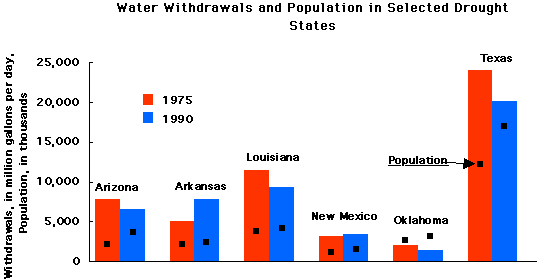

 Water use decreased in most of the drought-affected States (Arizona,
Arkansas, Louisiana, New Mexico, Oklahoma, and Texas) from 1975 to 1990 while
population increased at a rapid rate. Total water use for the six states
decreased 10 percent from 60,060 to 54,570 thousand acre-feet per year, and
population increased 24 percent (figure 1). Withdrawals of ground water
decreased 22 percent from 1975 to 1990 and surface-water withdrawals
decreased 3 percent. The dependency on ground water decreased from 42 percent
in 1975 to 38 percent in 1990.
Water use decreased in most of the drought-affected States (Arizona,
Arkansas, Louisiana, New Mexico, Oklahoma, and Texas) from 1975 to 1990 while
population increased at a rapid rate. Total water use for the six states
decreased 10 percent from 60,060 to 54,570 thousand acre-feet per year, and
population increased 24 percent (figure 1). Withdrawals of ground water
decreased 22 percent from 1975 to 1990 and surface-water withdrawals
decreased 3 percent. The dependency on ground water decreased from 42 percent
in 1975 to 38 percent in 1990.
The primary reason for the decrease was a decrease in irrigation use in most of the drought-affected States. Irrigation in Texas, the largest irrigation state in the area, decreased about 30 percent from 1975 to 1990 and acres irrigated in Texas decreased from 8.6 to 6.2 million acres.
Withdrawals for public supply increased almost 40 percent from 1975 to 1990
to meet the demands of the increased population. During 1990, public supply
accounted for about 11 percent of the total use compared to 6 percent in
1975. Irrigation withdrawals accounted form 48 percent of total use in 1990
compared to 51 percent in 1975.

